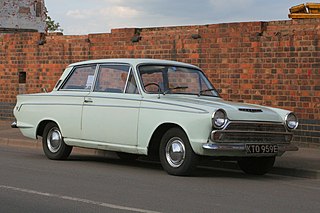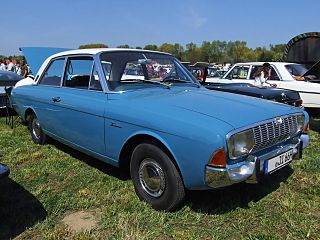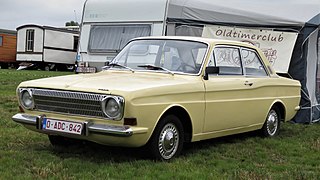See also
| This disambiguation page lists articles associated with the title Taunus. If an internal link led you here, you may wish to change the link to point directly to the intended article. |
Taunus can refer to the following:
| This disambiguation page lists articles associated with the title Taunus. If an internal link led you here, you may wish to change the link to point directly to the intended article. |

The Ford Taunus is a family car that was sold by Ford Germany throughout Europe. Models from 1970 onward were built on the same basic construction as the Ford Cortina MkIII in the United Kingdom, and later on the two car models were essentially the same differing almost only in the placement of the steering wheel. The model line was named after the Taunus mountain range in Germany and was first made in 1939 and continued through several versions until 1994.

The Taunus is a mountain range in Hesse, Germany, located north of Frankfurt. The tallest peak in the range is Großer Feldberg at 878 m; other notable peaks are Kleiner Feldberg and Altkönig.

The Ford Cortina is a car that was built by Ford of Britain in various guises from 1962 to 1983, and was the United Kingdom's best-selling car of the 1970s.

The Ford Transit is a range of light commercial vehicles produced by Ford since 1965. Sold primarily as a cargo van, the Transit is also built as a passenger van, minibus, cutaway van chassis, and as a pickup truck. Over 8,000,000 Transit vans have been sold, making it the third best-selling van of all time and have been produced across four basic platform generations, with various "facelift" versions of each.

The Ford Pinto engine was the unofficial but generic nickname for a four-cylinder internal combustion engine built by Ford Europe. In Ford sales literature, it was referred to as the EAO or OHC engine and because it was designed to the metric system, it was sometimes called the "metric engine". The internal Ford codename for the unit was the T88-series engine. European Ford service literature refers to it as the Taunus In-Line engine and the Lima In-Line (LL)

The Ford Taunus V4 engine was a 60° V4 piston engine with one balance shaft, introduced by Ford Motor Company in Germany in 1962. The German V4 was built in the Cologne plant and powered the Ford Taunus and German versions of the Consul, Capri, and Transit.

The Ford Sidevalve is a side valve from the British arm of the Ford Motor Company, often also referred to as the "English Sidevalve". The engine had its origins in the 1930s Ford Model Y, and were made in two sizes, 933 cc (56.9 cu in) or "8 HP", and 1,172 cc (71.5 cu in) or "10 HP". The early engines did not have a water pump as standard, instead relying on thermosiphon cooling as the Model T engine had. A water pump was added in 1953 for the 100E models when the engine was re-engineered to the point that few specifications are identical between the early and the latter series. The Sidevalve engine was used in many smaller Fords as well as farm vehicles, commercial vehicles and a marine version in boats. Production of the engine was stopped in 1962. Windscreen wipers were often driven by the vacuum generated in the inlet manifold.
Wesley Paul Dahlberg designed the Ford Taunus P3 17M, the Badewanne.

Ford-Werke GmbH is a German car manufacturer headquartered in Niehl, Cologne, North Rhine-Westphalia and a subsidiary of Ford of Europe, which in turn is a subsidiary of Ford Motor Company.

The European Ford Granada is a large executive car manufactured by Ford Europe from 1972 until 1994.

Uwe Bahnsen was a German car designer. After an apprenticeship as a window dresser Bahnsen studied at the College of Fine Arts in Hamburg. From 1958 to 1986 he held various positions with Ford Europe, most recently as vice president for design. During this time his designs included the Taunus 17m and the Capri II. Bahnsen was also a motor sport enthusiast, and in the 1960s he organised a Ford Works Team. He was a team member involved with the design of the Mk1 Capri, working with chief stylist Phil Clark.

The Ford Taunus G93A is a small family car that was produced by Ford Germany between 1939 and 1942 in succession to the Ford Eifel. It was the first car developed at Cologne by Ford Germany which previously had built cars originated by Ford businesses in the US or the UK. Production began on 30 April 1939, with the first car exhibited to the public in June 1939, less than six months before the outbreak of war in Europe.

The Ford Taunus P1 is a small family car which was produced by Ford Germany from 1952 until 1962. It was marketed as the Ford Taunus 12M, and, between 1955 and 1959, as the larger-engined Ford Taunus 15M. The company produced a succession of Ford Taunus 12M models until 1970, as the name was applied to a succession of similarly sized cars, but the first Taunus 12M models, based on the company's Taunus Project 1 (P1), remained in production only until 1962. In that year the Taunus P1 series was replaced by the Taunus P4 series.

The Ford Taunus 17 M is a middle sized family saloon/sedan that was produced by Ford Germany between August 1957 and August 1960. The Taunus 17M name was also applied to subsequent Ford models which is why the car is usually identified, in retrospect, as the Ford Taunus P2. It was the second newly designed German Ford to be launched after the war and for this reason it was from inception known within the company as Ford Project 2 (P2) or the Ford Taunus P2.

The Ford Taunus 17 M is a middle sized family saloon/sedan that was produced by Ford Germany between September 1960 and August 1964. The Taunus 17M name had been applied to the car's predecessor and it would apply also to subsequent Ford models which is why the 17M introduced in 1960 is usually identified, in retrospect, as the Ford Taunus P3. It was the third newly designed German Ford to be launched after the war and for this reason it was from inception known within the company as Ford Project 3 (P3) or the Ford Taunus P3.

The Ford Taunus 12 M is a small family car that was produced by Ford Germany between September 1962 and August 1966.

The Ford Taunus 17 M is a middle-weight family saloon/sedan that was produced by Ford Germany between 1964 and 1967. The entire range was first presented in September 1964 and volume production of the two and four door saloons/sedans began in November 1964. The "Turnier" version followed in January 1965 with coupé bodied cars coming along some time later.

The Ford Taunus 12 M is a range of large family saloons/sedans that were produced by Ford Germany between 1966 and 1970. There were two different engine sizes in the 12M. Two larger engines were available in the otherwise very similar Ford Taunus 15 M. From the outside the 15M was differentiated by its grill and rectangular headlights from the 12M which had round front lights. A complicating feature was the availability, at extra cost, of one of the larger engines from the 15M in the 12M.

The Ford P7 is a range of large family saloons/sedans produced by Ford Germany between autumn 1967 and December 1971. The P7 was marketed as the Ford 17M, Ford 20M and Ford 26M.

The Ford Taunus TC is a range of large family cars that were built by Ford Germany from 1970 until 1982. The Taunus TC was based on the same basic construction as the Ford UK's Cortina range, with the "TC" badge standing for Taunus Cortina.